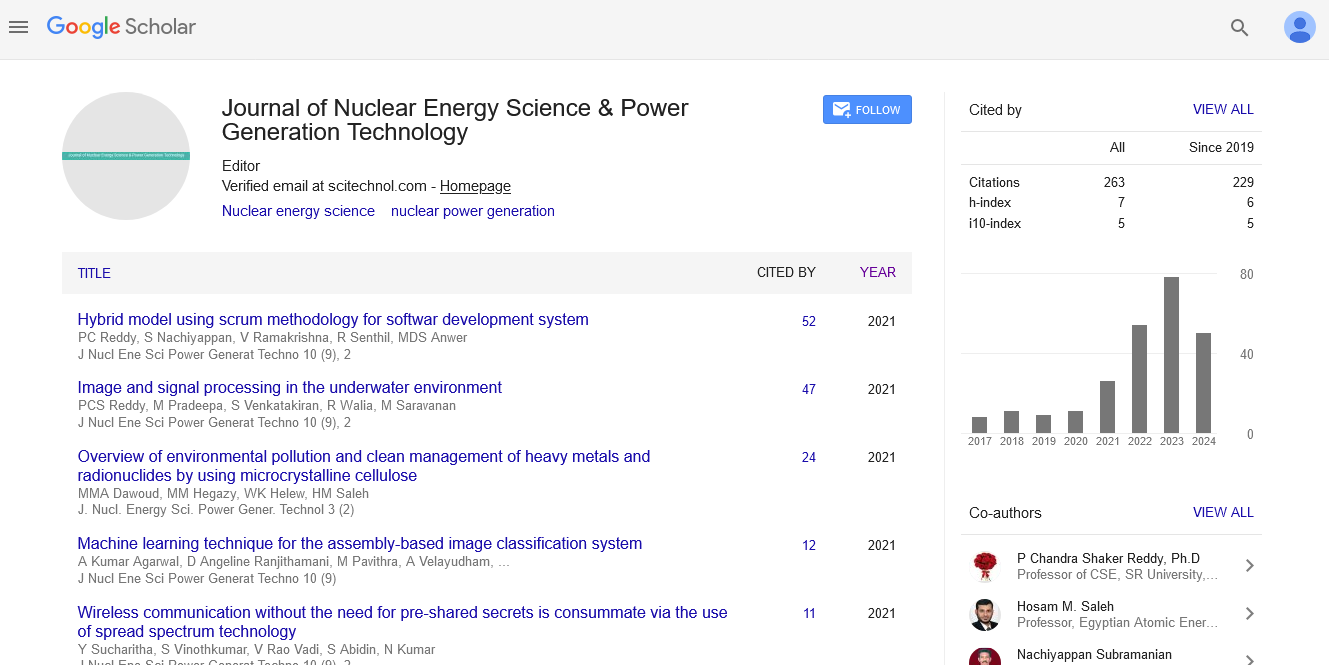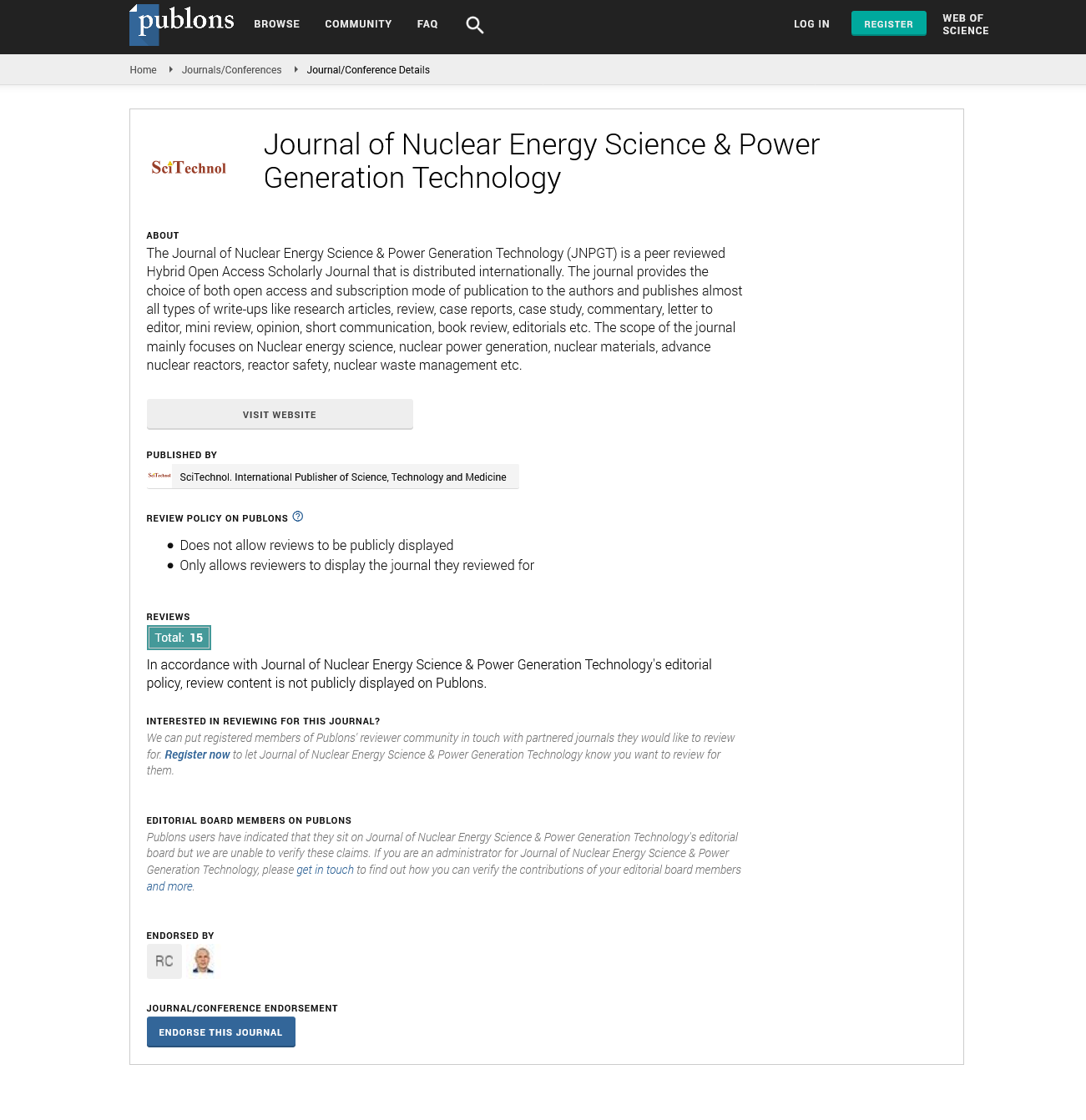Commentary, J Nucl Ene Sci Power Generat Technol Vol: 13 Issue: 5
Radioisotope Thermoelectric Generators: A Sustainable Energy Source for Remote and Space Applications
Saiur Weihnarh*
1Department of Nuclear Engineering, Seoul National University, Seoul, South Korea
*Corresponding Author: Saiur Weihnarh,
Department of Nuclear Engineering,
Seoul National University, Seoul, South Korea
E-mail: saiur_weihnarh@gmail.com
Received date: 26 August, 2024, Manuscript No. JNPGT-24-150412;
Editor assigned date: 28 August, 2024, PreQC No. JNPGT-24-150412 (PQ);
Reviewed date: 11 September, 2024, QC No. JNPGT-24-150412;
Revised date: 18 September, 2024, Manuscript No. JNPGT-24-150412 (R);
Published date: 25 September, 2024, DOI: 10.4172/2325-9809.1000415.
Citation: Weihnarh S (2024) Radioisotope Thermoelectric Generators: A Sustainable Energy Source for Remote and Space Applications. J Nucl Ene Sci Power Generat Technol 13:5.
Description
Power generation from radioisotopes is a position but significant form of energy production that utilizes the energy released from the radioactive decay of isotopes. This method has been extensively applied in space exploration, remote sensing equipment and other specialized fields where long-lasting, reliable energy sources are required. Different traditional power generation methods, which depend on on fossil fuels, nuclear fission, renewable sources, radioisotope-based power generators convert the heat from radioactive decay directly into electricity through thermoelectric devices. Radioisotopes are unstable isotopes that decay by emitting radiation, which can take the form of alpha particles, beta particles or gamma rays. The decay process releases significant amounts of energy in the form of heat.
The heat produced by the radioactive decay of certain isotopes can be converted into electricity using Thermoelectric Generators (TEGs), which activity the setback effect. In TEGs, a temperature difference between two materials generates an electric voltage which can then power devices. The choice of the radioisotope is essential for the design and effectiveness of a power system. Commonly used radioisotopes include Plutonium-238, Strontium-90 and Polonium-210. Each of these isotopes has different half-lives, heat outputs and radiation types making them suitable for various applications. Plutonium-238 is one of the most widely used isotopes due to its relatively long half-life (87.7 years) and high heat output making it best for long-duration missions like space exploration.
Applications of radioisotope power
One of the most important applications of radioisotope power is in space exploration. Radioisotope Thermoelectric Generators (RTGs) have been used in NASA's spacecraft since the 1960s, including famous missions like the Apollo Moon landings, the Voyager probes and the Mars rovers. RTGs are particularly useful for deep-space missions where solar power is impractical due to the lack of sunlight. For instance, the Voyager spacecraft which have been operating for over 45 years and are now beyond the solar system are powered by RTGs using plutonium-238. The consistent reliable energy from RTGs allows spacecraft to function in extreme environments far from any power source.
Remote power systems
Radioisotope power generators are also utilized in remote locations on Earth where conventional power sources are not feasible. Examples include powering lighthouses in the Arctic, unattended weather stations and deep-sea scientific equipment. These generators can operate for decades without maintenance making them perfect for locations that are difficult to access. In the military, radioisotope power has been used to power unmanned equipment, navigation buoys and remote sensors. These applications benefit from the longevity and reliability of radioisotope generators, which can provide power in severe or inaccessible environments without the need for refueling or servicing.
Advantages of radioisotope power generation
One of the key advantages of radioisotope-based power systems is their long lifespan. Since radioisotopes decay over many years they provide a steady and reliable source of heat that can be converted into electricity. This makes them perfect for long-duration missions or installations where servicing is impractical or impossible. Radioisotope power generators are highly reliable with no moving parts, meaning there are fewer points of failure compared to mechanical engines or turbines. Their simplicity and durability make them suitable for severe environments like outer space, the deep ocean or polar regions. Solar power, which is intermittent and depends on sunlight, radioisotope power provides a continuous output of energy, day and night, regardless of environmental conditions. This makes them particularly useful in environments where sunlight is weak or unavailable.
Conclusion
Another limitation is the relatively low power output compared to conventional power sources. While RTGs provide enough power for small-scale applications like spacecraft, they are not suitable for largescale electricity generation on Earth. Power generation from radioisotopes remains an important technology for specialized applications, particularly in space exploration and remote locations. While it is not a solution for mass power generation due to its cost, complexity and safety concerns its ability to provide long-lasting, reliable power in extreme environments makes it necessary. As the demand for energy in remote and inhospitable locations grows, radioisotope power may continue to play a essential role in future technological advancements.
 Spanish
Spanish  Chinese
Chinese  Russian
Russian  German
German  French
French  Japanese
Japanese  Portuguese
Portuguese  Hindi
Hindi 

